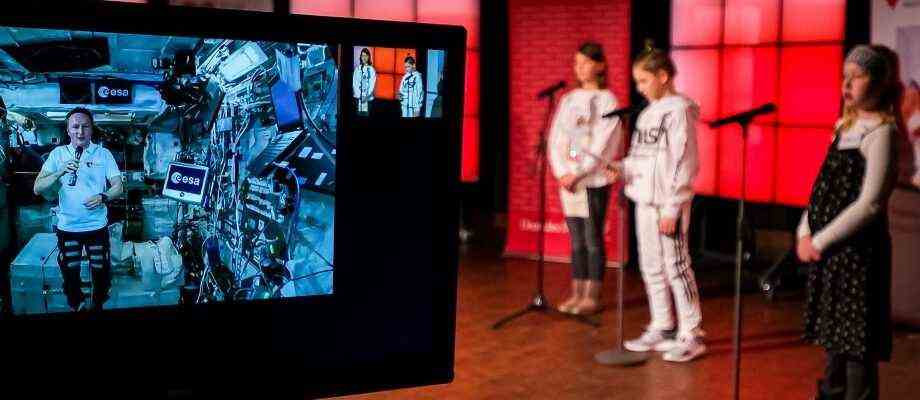You don’t often have the opportunity to make calls to space, not even as the head of the German Aerospace Center (DLR). It was also a first for Anke Kaysser-Pyzalla, 55, when she was switched to a video call to the international space station ISS via satellite on Saturday afternoon, in which the German astronaut Matthias Maurer is currently orbiting the earth. Kaysser-Pyzalla, who has been in office for a year, owed this opportunity to an action by the “KinderHerz Foundation”, which cares for children with congenital heart defects. Six of them, who are cared for in the local heart center, also had a say – from the Deutsches Museum.
What does the astronaut Maurer have to do with children with heart disease anyway? Well, the 51-year-old is the foundation’s ambassador and, as a materials scientist with a doctorate, researches materials that can also benefit heart patients. “Everyone knows the Teflon pan,” explained the foundation chairman, Sylvia Paul, at the beginning of the discussion that was broadcast on the Internet, “but only a few are familiar with the Nitrol screens, which can be used to close holes in children’s hearts.” As Maurer confirmed, he is actually experimenting with growing heart cells. It is a long-term project: “We are laying the foundation here that at some point a second ventricle can be operated on on a faulty heart.”
“Sometimes I just float in my module and feel like a butterfly”
Before Maurer appeared on the screens in the museum’s former planetarium, Federal President Frank-Walter Steinmeier joined the conversation from Berlin: “I’m delighted that we can go on a trip into space together today,” he said while still chatting a little with the more than less excited children. The American space agency Nasa then announced: “Houston calling!” There they did a sound check, and then Matthias Maurer could be seen – in the midst of boxes and devices, screens and cables. After a month on the ISS he was looking forward to a change, he said and revealed that he didn’t have much to do on Saturdays anyway: “Just tidy up and clean.”
The twelve-year-old Clara first asked him what such a space station was made of. “Made of many modules made of aluminum and titanium,” answered Maurer, the modules were “like caravans, many of which are linked to one another”.
Alessandro, ten years old, wanted to know whether Maurer was experimenting all the time or relaxing – and if so, how? Apart from the fact that he does two and a half hours of sport a day to counteract the muscle and bone loss caused by weightlessness, he likes to drift, said Maurer: “Sometimes I just float in my module and feel a bit like a butterfly. “
Other children from Nohfelden in Saarland, Maurer’s homeland, asked whether you smell and taste the same way in space as you do on earth? Using a steaming soup, Maurer explained how the rising air spreads scents. But since no air rises in weightlessness, you smell less. “Sometimes that might be a good thing,” he added, “because you can shower less often up here.” It is similar with the sense of taste: “We season everything here much stronger.”
“It doesn’t look very comfortable in the space station”
For nine-year-old Paul, showering was “really funny”. Otherwise, little was new to him, he assured him: He had prepared well with his parents and some videos. Isabelle, 11, said: “It doesn’t look very comfortable in the space station.” She had imagined a large window through which one could see the earth, and only a few devices to the left and right.
Binta, 12, on the other hand, was impressed by the way Maurer described the view through the window: That you don’t look down at the earth from the ISS, but look up. On earth, the sky appears blue – seen from space, “it is actually black,” reported the astronaut. And yet you see blue when you look up – that’s the earth. “A picture that is difficult to describe,” he admitted.
Felix, 13, nevertheless found that Matthias Maurer “explained very well”. He did know “that there is a lot of technology up there. It’s not a vacation”. And that with the shower “you could have imagined”. But he also found it exciting that you can’t smell and taste so good in space.
After 25 minutes, the conversation was over, the satellite connection to the ISS, which was speeding over South America at 28,000 kilometers per hour, gave no more. Matthias Maurer waved goodbye to the children from space. “It was a pleasure for me,” he said, “and also an affair of the heart.”

